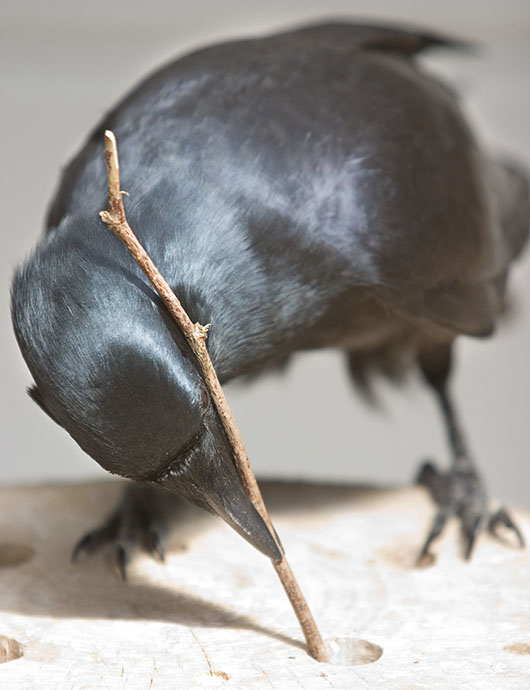Canny crows know their tools

Scientists at the University of St Andrews have discovered that New Caledonian crows, famous for their use of tools to extract hidden food, do not rely on guesswork when deploying one of their most complicated tool types; hooked stick tools. In fact, research published today suggests that they pay close attention to the features of each tool, ensuring that the hooked end is oriented correctly for snagging prey.
Dr Christian Rutz, team leader and co-author of the study, explained that “only two species are known to make hooks in nature – humans and New Caledonian crows. Hooked tools have clear functional polarity, and we were interested to see how crows avoid using their tools in the wrong orientation.”
 The study investigated hooked stick tools, which wild crows manufacture by using their bills to snip a forked stick out of a shrub. This stick is then ‘crafted’ by the careful removal of wood and bark, leaving a curved twig with a neat hook at the end. The crows use these tools to extract prey items such as insects from their hiding places in holes and crevices.
The study investigated hooked stick tools, which wild crows manufacture by using their bills to snip a forked stick out of a shrub. This stick is then ‘crafted’ by the careful removal of wood and bark, leaving a curved twig with a neat hook at the end. The crows use these tools to extract prey items such as insects from their hiding places in holes and crevices.
The researchers found that wild-caught crows consistently used replicas of these tools in the correct orientation, even when they were experimentally provided upside-down. This finding contrasts with earlier research by a different team, in which crows used trial-and-error to work out the correct orientation of a different type of hooked tool. Together, these studies suggest that crows are capable of observing tool features and using the information appropriately, but – like people – they sometimes try to take short-cuts.
The St Andrews team delved a little deeper into the decision-making process, by providing crows with a series of ‘trick’ tools, each of which had one feature (such as a hook) at one end, and another feature (such as curvature) at the other. Dr James St Clair, the lead author of the study, explained: “By recording which end of each tool the crows used to extract food, we were able to find out which particular features they considered most – and least – important.”
Of three tool features investigated, the hook was most important to crows deciding how to orient their tools, despite being the most subtle to human eyes. Although the relative importance of each of these features is unknown, it seems likely that the hook contributes the most to foraging success, suggesting that the crows’ decisions are geared towards the best possible outcome – and are thus ultimately adaptive.
Despite the striking results of the study, Dr St Clair cautions that “We still can’t say whether New Caledonian crows actually ‘understand’ how their tools function. But of course, this is also true of many humans I know!”
Notes to News Editors
The article ‘New Caledonian crows attend to multiple functional properties of complex tools’ will be published as part of a special issue of Philosophical Transactions of the Royal Society B, co-edited by Dr Rutz.
The Philosophical Transactions of the Royal Society is the oldest scientific journal in the world, with the first issue published in 1665
The article will be freely available online from 00:01(BST) on Monday 7 October at: http://rstb.royalsocietypublishing.org/
The study was funded by the UK’s Biotechnology and Biological Sciences Research Council (BBSRC).
New Caledonian crows are one of the world’s most proficient animal tool users. The species is restricted to the tropical islands of New Caledonia in the South Pacific, where it is known to use several different tool types to obtain beetle grubs and other concealed prey.
The crows used in this study were trapped in the wild, and held in aviaries for several days for behavioural experiments before being released unharmed.
The ‘research by a different team’ refers to a study by researchers at the University of Auckland (Holzhaider et al. 2008, Animal Cognition 11: 243-254), which found that crows used trial-and-error to correctly orient a different type of hooked tool, wide pandanus tools.
The authors’ contact details are as follows:
Dr James St Clair – [email protected] – +44 (0)1334 463 341
Dr Christian Rutz – [email protected] – +44 (0)7792 851 538
Category Research